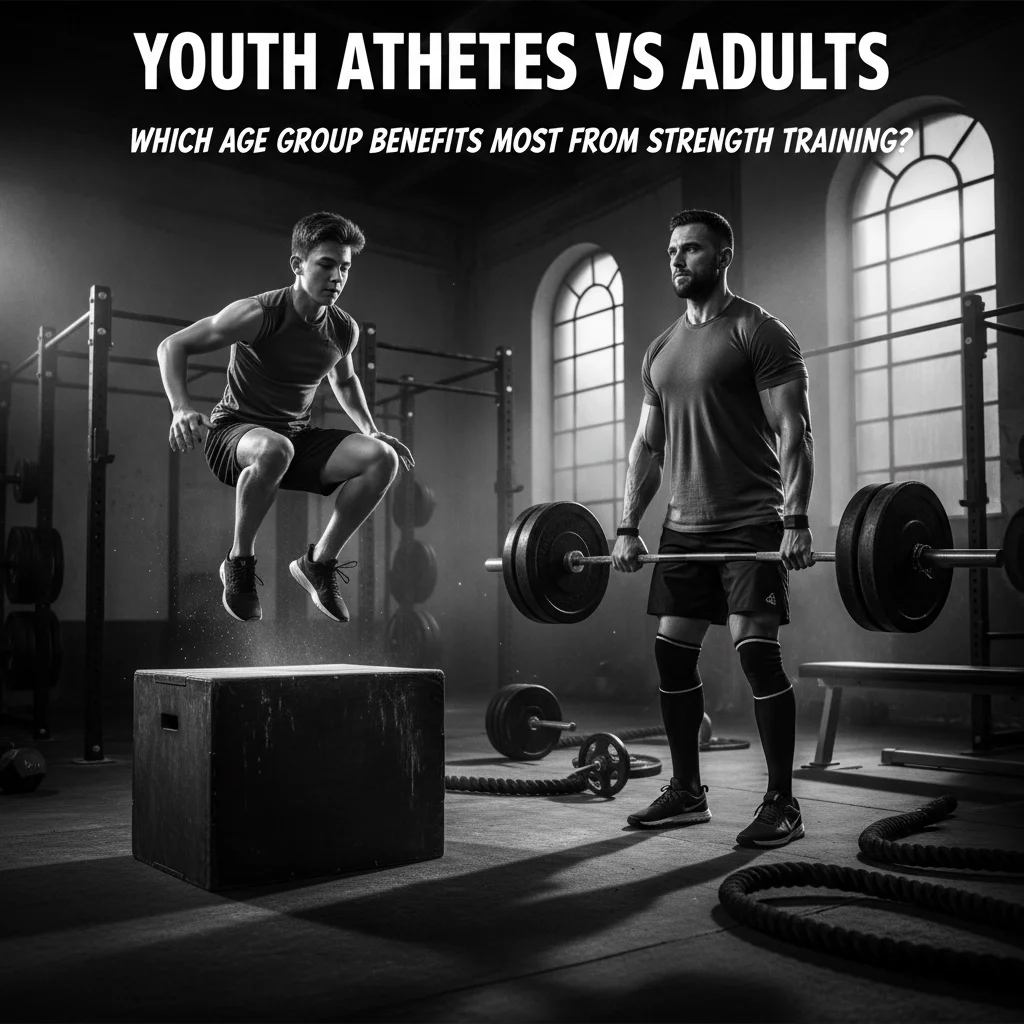Youth Athletes Vs Adults: Which Age Group Benefits Most from Strength Training?
Here's a question that comes up constantly in our Colorado Springs facility: Should you focus on getting your teenager into strength training, or is it more critical for adults to prioritize building muscle? The answer might surprise you, and it's rooted in some fascinating science about muscle tissue being what many sports medicine professionals call "the organ of longevity."
Let's dive into the research and break down exactly how different age groups benefit from strength training, and why muscle tissue might be your best investment for both performance and survival.
The Science: Muscle as Your Longevity Insurance Policy
Recent research has revolutionized how we think about muscle tissue. It's not just about looking good or lifting heavy: muscle mass directly correlates with your ability to survive cardiac events, trauma, cancer treatments, and virtually every major health challenge life throws at you.¹
A groundbreaking study published in the American Journal of Medicine followed over 3,600 adults for nearly 9 years and found that those with higher muscle mass had significantly lower mortality rates from all causes.² The researchers discovered that muscle mass was a better predictor of longevity than BMI, making it clear that what you're made of matters more than what you weigh.
But here's where it gets interesting: the benefits of strength training vary dramatically depending on when you start and what stage of life you're in.
Youth Athletes: The Foundation Years (Ages 6-18)
For young athletes, strength training isn't just about getting stronger: it's about building the blueprint for a lifetime of health and performance. The research here is compelling.
The Growth Advantage
Youth athletes can achieve strength gains of 30-50% in just 8-12 weeks of well-designed resistance training.³ What's remarkable is that prepubescent children show relative strength gains equal to or greater than adolescents, meaning younger kids can actually adapt faster to training stimuli.⁴
But the real magic happens in their developing nervous system. During these formative years, resistance training creates neuromuscular patterns that become deeply ingrained. Think of it as programming their movement software: once it's installed correctly, it runs more efficiently for life.
Beyond Just Getting Stronger
For youth athletes, strength training delivers benefits that extend far beyond the weight room:
Injury Prevention: A systematic review showed that strength training reduced sports injuries in young athletes by up to 40%.⁵ When you consider that ACL tears cost families an average of $17,000 and months of rehab, this alone makes training worthwhile.
Bone Density: The mechanical stress from resistance training during peak bone-forming years creates bone density benefits that last into adulthood.⁶ This is particularly crucial for female athletes, who face higher osteoporosis risks later in life.
Athletic Performance: Improved power, speed, agility, and coordination translate directly to better sports performance across all activities.⁷
Mental Health: Youth who participate in structured strength training show improved self-esteem, confidence, and better stress management skills.⁸
Adults: The Preservation and Optimization Phase (Ages 19-50)
If youth training is about building the foundation, adult strength training is about preserving and optimizing what you've built. But don't mistake this for maintenance mode: adults can still achieve remarkable adaptations.
The Metabolic Powerhouse
Adults in their 20s and 30s can use strength training to maximize their physical prime. During this period, muscle tissue acts as a metabolic furnace, burning calories 24/7 and regulating blood sugar more effectively than any medication.⁹
Research shows that each pound of muscle tissue burns approximately 6-10 calories per day at rest, meaning a 10-pound increase in muscle mass could increase your daily caloric expenditure by 60-100 calories without any additional activity.¹⁰
Fighting the Decline
Here's a sobering fact: starting around age 30, we lose approximately 3-8% of our muscle mass per decade.¹¹ This isn't just about aesthetics: this muscle loss directly impacts your metabolic health, bone density, and functional capacity.
Adults who maintain consistent strength training can not only prevent this decline but actually increase muscle mass well into their 40s and 50s. A study in the Journal of Strength and Conditioning Research found that previously untrained adults could gain 2-4 pounds of muscle in just 10 weeks of resistance training.¹²
Older Adults: The Survival Years (Ages 50+)
This is where the "muscle as organ of longevity" concept becomes most apparent. For older adults, muscle tissue isn't just about performance: it's literally about survival.
The Cardiac Connection
Cardiovascular disease remains the leading cause of death in the United States, but muscle mass plays a protective role that many people don't realize. A study published in the Journal of the American Heart Association found that individuals with higher muscle mass had a 20% lower risk of cardiovascular events.¹³
The mechanism is fascinating: muscle tissue acts as a glucose sink, helping regulate blood sugar and reducing inflammation, two major risk factors for heart disease. Additionally, the cardiovascular conditioning that comes with resistance training strengthens the heart muscle itself.
Trauma Recovery and Resilience
Perhaps most importantly for older adults, muscle mass directly correlates with survival rates from traumatic events. Research from trauma centers shows that patients with higher muscle mass have:
Better surgical outcomes: More muscle provides protein reserves for healing and recovery.¹⁴
Reduced hospital stays: Higher muscle mass correlates with faster recovery times.¹⁵
Lower mortality rates: In ICU patients, muscle mass is one of the strongest predictors of survival.¹⁶
A particularly striking study followed hip fracture patients and found that those with higher pre-injury muscle mass had 60% better survival rates at one year post-fracture.¹⁷
Quality of Life: The Universal Benefit
Regardless of age, strength training dramatically improves quality of life through enhanced mobility and functional capacity.
Mobility and Independence
Strength training improves not just raw strength but also:
Balance and coordination (reducing fall risk by up to 37%)¹⁸
Joint stability and range of motion
Functional movements like getting up from chairs, carrying groceries, and climbing stairs
Mental Health Benefits
The psychological benefits of strength training are remarkable across all age groups. Research shows resistance training can be as effective as antidepressant medication for treating mild to moderate depression.¹⁹ The mechanism involves increased production of BDNF (brain-derived neurotrophic factor), which supports brain health and cognitive function.
The Verdict: Who Benefits Most?
After examining the research, one thing became evident: every age group benefits from strength training, but in different ways.
Youth athletes benefit most from building the foundation: creating movement patterns, bone density, and habits that will serve them for life. The neuroplasticity and rapid adaptation capabilities of young people make this the most efficient time to build strength and movement competency.
Adults benefit most from optimization and preservation: maximizing their physical capabilities while preventing age-related decline. This is the sweet spot for performance gains while building the muscle mass that will protect them later in life.
Older adults benefit most from survival and independence: maintaining the muscle mass that literally keeps them alive and functional. For this population, strength training isn't optional: it's essential healthcare.
Your Next Steps
The research is clear: regardless of your age, strength training should be a non-negotiable part of your health routine. But the approach should be tailored to your life stage and goals.
At WorkTime Athletic Performance, we understand everyone is different, and that cookie-cutter programs don't work. Whether you're training a youth athlete, optimizing adult performance, or helping an older adult maintain independence, the program needs to match the physiology and goals.
The question isn't whether you should be strength training: it's whether you're doing it in the most effective way for your age and goals. Because when it comes to building your body's best defense against aging, disease, and injury, muscle truly is the ultimate investment in your future.
References:
Wolfe RR. The underappreciated role of muscle in health and disease. Am J Clin Nutr. 2006;84(3):475-482.
Srikanthan P, Karlamangla AS. Muscle mass index as a predictor of longevity in older adults. Am J Med. 2014;127(6):547-553.
Faigenbaum AD, Kraemer WJ, Blimkie CJ, et al. Youth resistance training: updated position statement paper from the national strength and conditioning association. J Strength Cond Res. 2009;23(5 Suppl):S60-79.
Ramsay JA, Blimkie CJ, Smith K, et al. Strength training effects in prepubescent boys. Med Sci Sports Exerc. 1990;22(5):605-614.
Lauersen JB, Bertelsen DM, Andersen LB. The effectiveness of exercise interventions to prevent sports injuries: a systematic review and meta-analysis of randomised controlled trials. Br J Sports Med. 2014;48(11):871-877.
Heinonen A, Sievänen H, Kannus P, et al. High-impact exercise and bones of growing girls: a 9-month controlled trial. Osteoporos Int. 2000;11(12):1010-1017.
Lesinski M, Prieske O, Granacher U. Effects and dose-response relationships of resistance training on physical performance in youth athletes: a systematic review and meta-analysis. Br J Sports Med. 2016;50(13):781-795.
Schranz N, Tomkinson G, Olds T. What is the effect of resistance training on the strength, body composition and psychosocial status of overweight and obese children and adolescents? A systematic review and meta-analysis. Sports Med. 2013;43(9):893-907.
Poehlman ET, Melby C. Resistance training and energy balance. Int J Sport Nutr. 1998;8(2):143-159.
Wang Z, Ying Z, Bosy-Westphal A, et al. Evaluation of specific metabolic rates of major organs and tissues: comparison between men and women. Am J Hum Biol. 2012;24(3):333-338.
Lexell J, Taylor CC, Sjöström M. What is the cause of the ageing atrophy? Total number, size and proportion of different fiber types studied in whole vastus lateralis muscle from 15- to 83-year-old men. J Neurol Sci. 1988;84(2-3):275-294.
Kraemer WJ, Adams K, Cafarelli E, et al. American College of Sports Medicine position stand. Progression models in resistance training for healthy adults. Med Sci Sports Exerc. 2002;34(2):364-380.
Chin SO, Rhee SY, Chon S, et al. Sarcopenia is independently associated with cardiovascular disease in older Korean adults: the Korea National Health and Nutrition Examination Survey (KNHANES) from 2009. PLoS One. 2013;8(3):e60119.
Lieffers JR, Bathe OF, Fassbender K, et al. Sarcopenia is associated with postoperative infection and delayed recovery from colorectal cancer resection surgery. Br J Cancer. 2012;107(6):931-936.
Englesbe MJ, Patel SP, He K, et al. Sarcopenia and mortality after liver transplantation. J Am Coll Surg. 2010;211(2):271-278.
Moisey LL, Mourtzakis M, Cotton BA, et al. Skeletal muscle predicts ventilator-free days, ICU-free days, and mortality in elderly ICU patients. Crit Care. 2013;17(5):R206.
Hida T, Shimokata H, Sakai Y, et al. Sarcopenia and sarcopenic leg as potential risk factors for acute osteoporotic vertebral fracture among older women. Eur Spine J. 2016;25(11):3424-3431.
Sherrington C, Fairhall NJ, Wallbank GK, et al. Exercise for preventing falls in older people living in the community. Cochrane Database Syst Rev. 2019;1(1):CD012424.
Gordon BR, McDowell CP, Hallgren M, et al. Association of efficacy of resistance exercise training with depressive symptoms: meta-analysis and meta-regression analysis of randomized clinical trials. JAMA Psychiatry. 2018;75(6):566-576.



